| Author |
Message |
|
Peter Johnsson
Industry Professional
|
 Posted: Wed 03 Apr, 2013 4:30 am Post subject: Long Sword for Solingen 2013 Posted: Wed 03 Apr, 2013 4:30 am Post subject: Long Sword for Solingen 2013 |
 |
|
Over the coming days and weeks I´ll post updates on the progress of the making of a long sword that I hope to have finished for the knife maker show at the Deutsches Klingenmuseum in Solingen on the 4th and 5th of May.
Currently I am working on the blade with stones and emery paper to bring out the proper shape refine the lines and bring out a good surface. So far it has passed final grinding on the belt grinder and is now taken through the first stages of hand sanding.
The sword is of a type of sword that there are a number of survivors. Oakeshott placed members of this group into different types. Examples can be found in his "Records of the Medieval Sword":
XVII.9 on page 167
XVII.12 on page 170
XIX.9-10 on page 206
XXa.1 on page 212
The common features of these swords is that they all have a long ricasso, often with groves or fullers on each side of the central narrow fuller.
The blade is usually very pointy, with most examples being specialized for the thrust. The XIX.9 & XIX.10 are both slim cut and thrust blades.
All swords in the group have long grips of hand and half or two hand size.
I would like to add to tis group two swords that belongs to the Castillion find. One of these is published in "Records" as XXa.2 on page 213. These are single hand swords with C&T blades but share the same feature of the strong fullered ricasso.
The cross section of the blade is most often hexagonal after the fuller. Sometimes the point becomes a strong diamond cross section. The XIX examples have a (rounded) diamond section after the ricasso, as does the XXa.2.
The sword I am working on has a flat hexagonal section after the ricasso. It is intended for both cut and thrust, with a blade that is rather thin and flexible. It will be light (around 1.4 kilos) for its size: a total of 128 cm, with a blade of 960 cm.
The design is developed with the help of my hypothesis for geometric design of swords. The dynamic properties is based on period long swords of similar type and size.
You can follow the development of this project on my Facebook page (Peter Johnsson Swordsmith) and my home page, but I shall also post updates on this thread over time.
 Attachment: 28.8 KB Attachment: 28.8 KB

Geometric plan of the proportions of the blade.
 Attachment: 69.46 KB Attachment: 69.46 KB
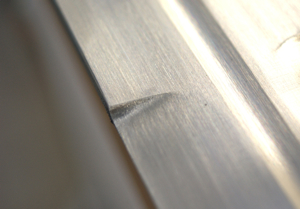
 Attachment: 63.49 KB Attachment: 63.49 KB

 Attachment: 73.02 KB Attachment: 73.02 KB
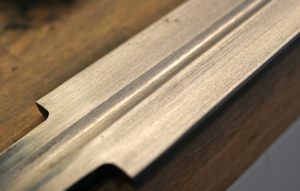
Last edited by Peter Johnsson on Wed 03 Apr, 2013 6:45 am; edited 1 time in total
|
|
   |
 |
Bryan Heff

|
 Posted: Wed 03 Apr, 2013 5:37 am Post subject: Posted: Wed 03 Apr, 2013 5:37 am Post subject: |
 |
|
What was the purpose of a ricasso on swords of this size? Was it for half swording, a cosmetic/fashion reason....was it practical from a strength standpoint or from a need to not have to deal with sharpening that section?
I don't have any sort of background in WMA, but if I am not mistaken, the images of half swording I have seen, seems like the off hand would be grabbing the blade further up than the ricasso area.
|
|
  |
 |
|
Peter Johnsson
Industry Professional
|
 Posted: Wed 03 Apr, 2013 6:02 am Post subject: Posted: Wed 03 Apr, 2013 6:02 am Post subject: |
 |
|
| Bryan Heff wrote: | What was the purpose of a ricasso on swords of this size? Was it for half swording, a cosmetic/fashion reason....was it practical from a strength standpoint or from a need to not have to deal with sharpening that section?
I don't have any sort of background in WMA, but if I am not mistaken, the images of half swording I have seen, seems like the off hand would be grabbing the blade further up than the ricasso area. |
As with most these things it is difficult to give definite answers. My opinion is that the ricasso served at least three functions (but there is quite possibly additional reasons apart from these).
First it is an area where you get a very sturdy and resilient base for pressing against the opponents blade. If you would block an incoming blow, a ricasso will be less likely to chip or dent.
*But* looking at swords *without* ricasso, it is not very common to find deep cuts or gouges in this part of the blade, so it must not have been a major setback, *not* to have a ricasso for this reason.
Secondly, a ricasso will allow you to finger the guard with no risk of cutting yourself on your own blade. But, again, we see how this is done also on swords *without* ricasso in period art. It must therefore not have been a major reason as to why a ricasso is formed at the base of the blade.
Thirdly, a ricasso will have an impact on the distribution of mass in a blade. It will therefore have an effect on the self balance of the bare blade and because of this have an effect on the dynamic properties of the sword: how it feels in the hand and how it will want to behave in motion. It will also change how a blade typically flex, moving the apex of the curvature forwards toward the point, compared to a sword with a blade of identical dimensions, but without a ricasso.
...So, perhaps we can venture a guess that it is a combination of these factors that motivates the shaping of a ricasso at the base of the blade?
|
|
   |
 |
Jeffrey Hedgecock
Industry Professional

|
 Posted: Fri 05 Apr, 2013 10:05 pm Post subject: Posted: Fri 05 Apr, 2013 10:05 pm Post subject: |
 |
|
Peter,
I'm curious if there's historical evidence for your hypothesis regarding basing sword proportion on geometric formulae. I haven't run across such theory in my research and would be very interested to know if you've found something.
Also, have you applied your ideas to many other swords? I'm interested to know if the theory fits with other survivals.
Thanks!
Cheers,
Jeffrey Hedgecock
Historic Enterprises, Inc.
WorldJoust Tournaments™
|
|
   |
 |
|
Peter Johnsson
Industry Professional
|
 Posted: Sat 06 Apr, 2013 1:19 am Post subject: Posted: Sat 06 Apr, 2013 1:19 am Post subject: |
 |
|
Hi Jeffrey,
Evidence for my hypothesis is circumstantial.
The hypothesis has not been presented in its full yet, nor have I presented the full process of analysis nor all the criteria I use to evaluate if a swords seems to be the result of geometric design or not. I shall return to this in articles on my home page and perhaps in a larger publication.
The method I use follows the same techniques and principles of development as the geometric drawings used as the basis for abbeys, churches and cathedrals. Those are the most well preserved and detailed construction drawings we have from the period.
We know that other craftsmen used geometric drawing to plan, design and lay out their work but there is very little surviving of the actual drawings themselves. Geometric drawing has ancient traditions among artist, artisans and engineers. It is telling that the one of the best sources on architecture in the classical period is by Vitruvius. He was not just an architect, but a military engineer who followed Julius Caesar on his gallic wars. Even though Vitruvius was a rather dry and very practical minded person, he also hints at some aspects of geometry that has to do with Man´s place in Cosmos. Geometry was a way to get things *right* on many levels, both practical and esoteric.
Some late 15th century handbooks in geometric design tell about the methods used by master stone masons and goldsmiths. Theophilus also describe the use of the compass and straight edge in layout work.
Why use geometry in the making of swords? Isn´t it just a complicated and roundabout way to reach a simple solution?
-To us it might seem so since we do not have the direct practical need to learn its use in our modern world. We are not familiar with the simple handling of the tools used in drawing and the thought processes involved might seem arcane and complex.
If we are making just one sword, that may well be the case, but if we think about how swords were produced in large numbers and how labour was divided between several specialist craftsmen it is more evident that a system for specification of parts is not only practical but perhaps even necessary.
It is easy to take he shape of the medieval sword for granted. Its form is so strong and simple. Yet it is also subtle. When we look at contemporary attempts to replicate medieval swords we see how easy it is to get it wrong.
-A "simple" sword with straight guard and brazil nut pommel is just that, isn´t it: a long blade with a hilt consisting of a grip and straight guard and a lenticular shaped bob of iron.
Yet, when we compare contemporary attempts with the original swords they often seem to lack something. They are often slightly "out of tune" somehow.
In a time when many craftsmen may have been illiterate, when there were no internationally shared standards of measurements then geometric drawing is a very handy method to set out dimensions and convey to others the principles of a design. Knowledge in geometric drawing does not mean you have to be literate. You do not have to have a university degree to learn it. You can learn its use and application merely by watching it being preformed by someone who knows it. It is in fact rather easy to learn even though there are some specific rules to follow. This is probably how this knowledge was imparted to new generations of craftsmen.
Geometric designs are easy to memorize. They are easy to duplicate. You can easily scale the product to any dimension based on a geometric design. There is no need to round of measurements: you can take them directly from a drawing: this takes away the need to express dimensions in fractions of measure units.
So far I have analyzed some 80+ swords. Many do seem to follow a geometric plan for their proportions but not all. You cannot stretch the basic grid to fit just any sword. There is in fact a rather narrow margin where swords fit all the restrictions of a geometric plan.
What I have seen from 11th to 16th century swords hints that there is a pattern and perhaps even an evolution of the use of geometry.
-But, *much* more work is needed on the hypothesis as well as more critical evaluation.
What I propose is rather main stream in other fields of art history. It is just that these ideas has never before been applied to the study of swords.
On my home page there are some more articles on this theme, if you are interested. There are also two articles published in print: the Park Lane Arms Fair catalogue of 2012 has a presentation of three swords, and the catalogue to the exhibit at the Wallace Collection: "The Noble Art of the Sword" has one article presenting the geometry of three swords in the Wallace Collection.
|
|
   |
 |
Jeffrey Hedgecock
Industry Professional

|
 Posted: Mon 08 Apr, 2013 11:28 pm Post subject: Posted: Mon 08 Apr, 2013 11:28 pm Post subject: |
 |
|
Hi Peter,
Thank you very much for your in-depth explanation of your theory. It is very interesting how you have derived it.
While I am interested and receptive to new information and perspectives on history and our understanding of it, I am primarily interested in that which can be supported by primary historical evidence, whether written, pictorial or extant artifact.
If you possess historical evidence more directly supporting your theory, or run across some at any point, I would be very interested to hear it.
Cheers,
Jeffrey Hedgecock
Historic Enterprises, Inc.
WorldJoust Tournaments™
|
|
   |
 |
|
Peter Johnsson
Industry Professional
|
 Posted: Tue 09 Apr, 2013 2:30 am Post subject: Posted: Tue 09 Apr, 2013 2:30 am Post subject: |
 |
|
please remove post
Last edited by Peter Johnsson on Tue 09 Apr, 2013 2:01 pm; edited 3 times in total
|
|
   |
 |
|
Peter Johnsson
Industry Professional
|
|
   |
 |
|
Peter Johnsson
Industry Professional
|
 Posted: Thu 18 Apr, 2013 2:22 am Post subject: Posted: Thu 18 Apr, 2013 2:22 am Post subject: |
 |
|
Another update!
This time some detail work on the hilt parts and a short video demonstrating how the proportions of the sword are defined with geometry.
http://www.peterjohnsson.com/the-making-of-a-long-sword/
Thanks!
 Attachment: 63.47 KB Attachment: 63.47 KB

|
|
   |
 |
Bryan Heff

|
 Posted: Thu 18 Apr, 2013 5:03 am Post subject: Posted: Thu 18 Apr, 2013 5:03 am Post subject: |
 |
|
Peter -
That video is beyond cool. I have a question though as I am not quite getting one part of the geometry that the video is laying out. Its how the pommel diameter is calculated. The video mentions that the diameter is based on the diagonal arcs that cross the square. The first 2 diagonal arcs make sense as they start in the center of the left side and end at the center of the top/bottom side respectively. The second 2 arcs seem to start in a somewhat random place along the length of the right side. Almost in the middle of one of the smaller (7) circles, but not quite (at least to my eyes). Are those arc starting points random or am I missing something?
Very very interesting your theory on geometry and swords. I really enjoy reading these posts.
|
|
  |
 |
|
Peter Johnsson
Industry Professional
|
 Posted: Thu 18 Apr, 2013 5:42 am Post subject: Posted: Thu 18 Apr, 2013 5:42 am Post subject: |
 |
|
| Bryan Heff wrote: | Peter -
That video is beyond cool. I have a question though as I am not quite getting one part of the geometry that the video is laying out. Its how the pommel diameter is calculated. The video mentions that the diameter is based on the diagonal arcs that cross the square. The first 2 diagonal arcs make sense as they start in the center of the left side and end at the center of the top/bottom side respectively. The second 2 arcs seem to start in a somewhat random place along the length of the right side. Almost in the middle of one of the smaller (7) circles, but not quite (at least to my eyes). Are those arc starting points random or am I missing something?
Very very interesting your theory on geometry and swords. I really enjoy reading these posts. |
Hi Bryan, and thanks!
The first pair of diagonal arcs are constructed by placing one point of the compass in one of the leftmost corners of the square and the other point on the midline of the construction. You actually make a quarter circle with the same radius as the first circle, but with its centre placed in the corner of the square.
The second pair of arcs are made to be tangent to the first: draw one of them by placing the point of the compass in one of the rightmost corners of the square and measure out the point where the arc will touch one of the first diagonal arcs that are placed diagonally across. This makes the second larger arcs tangent to the first two arcs. The larger diagonal arcs will cut the square in strategic places, slightly inside the corners of the square.
By drawing a perpendicular line between the two leftmost end points you will get the centre point where the line cross the main horizontal line. This circle has its mid point/centre where the perpendicular line cross the horizontal line and its circumference is defined by the side of the square.
The the place where the two large diagonal arcs cut the rightmost side of the square defines the width of the guard.
As you see, the same device defines the most important parts and proportions of the hilt all at once. This kind of strategy in geometric construction can be observed in surviving medieval construction plans for ecclesiastic architecture. There is an economy in the number of features involved in the design. Each element should ideally be the basis for several operations or definitions. This way you can achieve a sense of wholeness in the work, an impression that all the parts belong together in a harmonious way.
I hope this all makes sense.
Thanks for your question!
I see how I need to make things more clear in my demos. This is important to know!
|
|
   |
 |
|
Eric W. Norenberg
|
 Posted: Fri 19 Apr, 2013 9:54 am Post subject: Posted: Fri 19 Apr, 2013 9:54 am Post subject: |
 |
|
Hello Peter!
Thank you so much for sharing the process of making this longsword with all of us. The video posted on your website describing the proportioning of this sword is fantastic, I've watched many of your other videos in this vein but this one, I think, is especially clear and easy to grasp. I've long been in your camp with this theory, I've often worked it from numerical math (ratios translated into hard measurements) when analyzing favorite swords but you've really hit it here. We know for a fact that the building trades used these ideas not only to generate floor and elevation plans but also to produce templates to produce uniform moldings; these templates could be reproduced at adjusted sizes using geometric layouts to upsize or downsize a molding for buildings of different scale (say, a cathedral church vs a chapel). Your ideas here seem to fit both "plan" and "template" purposes and I feel like, through your work (and your willingness to share your process) we are all getting a pretty accurate peek inside the heads of the medieval sword makers themselves.
On a more visceral level- I am thrilled to see a type XIX that veers from the more commonly quoted form, meaning the "Alexandria" type with the incised lines on the ricasso. This one seems to lie in that grey area between XIX and XX types, maybe? The gothic furniture on that specific blade form just makes my heart skip a beat. Maybe a bit over-medievalized, in the fashion of Schmidt and Viollet-le-Duc, which makes it just about perfect!
Excelsior!
|
|
  |
 |
|
Peter Johnsson
Industry Professional
|
 Posted: Sun 19 May, 2013 1:07 pm Post subject: Posted: Sun 19 May, 2013 1:07 pm Post subject: |
 |
|
| Eric W. Norenberg wrote: | Hello Peter!
Thank you so much for sharing the process of making this longsword with all of us. The video posted on your website describing the proportioning of this sword is fantastic, I've watched many of your other videos in this vein but this one, I think, is especially clear and easy to grasp. I've long been in your camp with this theory, I've often worked it from numerical math (ratios translated into hard measurements) when analyzing favorite swords but you've really hit it here. We know for a fact that the building trades used these ideas not only to generate floor and elevation plans but also to produce templates to produce uniform moldings; these templates could be reproduced at adjusted sizes using geometric layouts to upsize or downsize a molding for buildings of different scale (say, a cathedral church vs a chapel). Your ideas here seem to fit both "plan" and "template" purposes and I feel like, through your work (and your willingness to share your process) we are all getting a pretty accurate peek inside the heads of the medieval sword makers themselves.
On a more visceral level- I am thrilled to see a type XIX that veers from the more commonly quoted form, meaning the "Alexandria" type with the incised lines on the ricasso. This one seems to lie in that grey area between XIX and XX types, maybe? The gothic furniture on that specific blade form just makes my heart skip a beat. Maybe a bit over-medievalized, in the fashion of Schmidt and Viollet-le-Duc, which makes it just about perfect!
Excelsior! |
Thank you Eric!
Yes you are correct: the sword *is* a romantic flirt with the gothic style. It is a homage piece where I have let myself run a bit free with the style. The design is a picking of favorite details and elements from different swords. Perhaps a way to continue building on a tradition, not simply replicating it? Perhaps. A less kind eye would say I bastardize it. Someone who likes it might notice my admiration for the work of the old masters.
Last edited by Peter Johnsson on Sun 19 May, 2013 1:17 pm; edited 1 time in total
|
|
   |
 |
|
Peter Johnsson
Industry Professional
|
 Posted: Sun 19 May, 2013 1:15 pm Post subject: Posted: Sun 19 May, 2013 1:15 pm Post subject: |
 |
|
So the sword is finished and has found a good home with a caring owner.
Below are some snapshots of the finished sword.
In a little while I will complete the article on my homepage that describes the making of this sword.
For the enjoyment of you fellow forumites, I post these images. Hope you like them.
 Attachment: 51.03 KB Attachment: 51.03 KB

Full length shot
 Attachment: 135.95 KB Attachment: 135.95 KB

Hilt and ricasso. The hollow grind of the ricasso is actually visible in this pic.
 Attachment: 126.4 KB Attachment: 126.4 KB
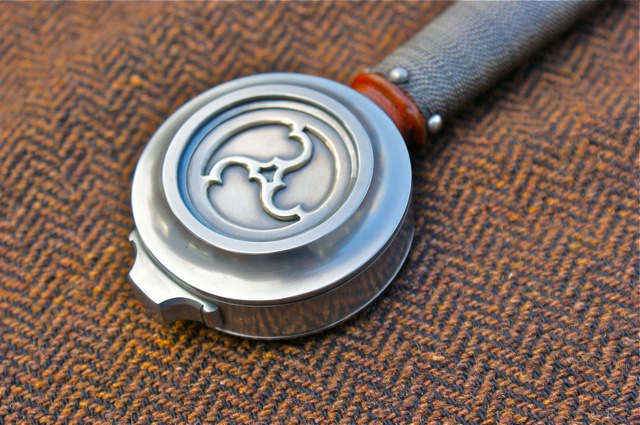
Pommel detail.
 Attachment: 59.89 KB Attachment: 59.89 KB
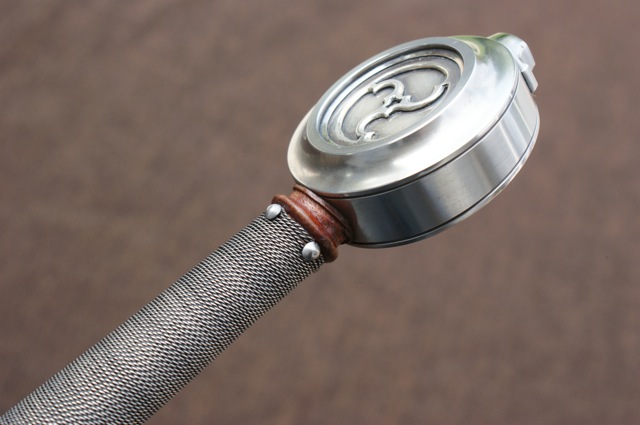
The pommel is tapered towards the rivet block. The decorative lines are cut with a file.
 Attachment: 111.77 KB Attachment: 111.77 KB
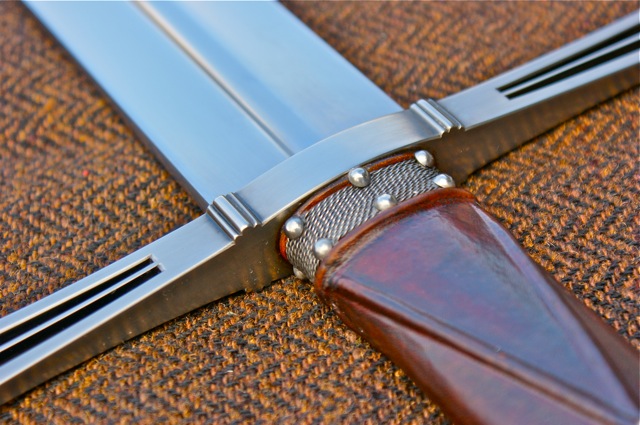
Detail of the grip meeting the guard. There is a narrow fold of the leather that marks the end of the grip and holds the hilt together visually. This is something that you can see also on original swords of the period.
|
|
   |
 |
Roger Hooper

|
 Posted: Sun 19 May, 2013 1:46 pm Post subject: Posted: Sun 19 May, 2013 1:46 pm Post subject: |
 |
|
That's quite beautiful. First time I've seen the sword as a whole. FWIW, there's a superficial resemblence to the hilt of Del Tin's DT5155/57. I love the hollow ground ricasso.
That sword must be a joy to wield.
|
|
  |
 |
|
Peter Johnsson
Industry Professional
|
 Posted: Sun 19 May, 2013 1:53 pm Post subject: Posted: Sun 19 May, 2013 1:53 pm Post subject: |
 |
|
| Roger Hooper wrote: | That's quite beautiful. First time I've seen the sword as a whole. FWIW, there's a superficial resemblence to the hilt of Del Tin's DT5155/57. I love the hollow ground ricasso.
That sword must be a joy to wield. |
Thank you Roger!
Yes the sword is very light and nimble in the hand. It weighs some 1.4 kilos, but feels lighter. The edges are very sharp and keen.
The Del Tin sword is a replica of a famous sword in the Royal Armouries in Leeds. That particular sword is thought to be a recent replica of the 19th century. However, the Leeds sword incorporates details that are found on authentic period swords. There is one example of just this kind of guard and grip configuration on a sword in the Bayerisches Nationalmuseum in Munich.
|
|
   |
 |
Bryan Heff

|
 Posted: Sun 19 May, 2013 2:23 pm Post subject: Posted: Sun 19 May, 2013 2:23 pm Post subject: |
 |
|
|
Beautiful work! I didn't notice it at first, in the full sword pic, but the later pic that shows a close up of the grip where it meets the guard, that small bit of wire wrap detail is phenomenal. I don't think I have ever seen that before. It really ties the whole grip together by bridging the gap between the leather wrap and the wire on the lower half. I really like that bit of detail.
|
|
  |
 |
|
Rob Miller
Industry Professional
|
 Posted: Mon 20 May, 2013 3:27 am Post subject: Posted: Mon 20 May, 2013 3:27 am Post subject: |
 |
|
|
meticulous and faultless work that has me in awe of your attention to detail,crisp clean and perfect,and i am intrigued about your geometric theory,relating this to Medieval architecture is a very valid point,vesica pisces etc.
|
|
    |
 |
|
Adam Simmonds
|
 Posted: Mon 20 May, 2013 5:28 am Post subject: Posted: Mon 20 May, 2013 5:28 am Post subject: |
 |
|
|
That's just gorgeous.
|
|
  |
 |
Bruno Giordan

|
 Posted: Mon 20 May, 2013 6:09 am Post subject: Posted: Mon 20 May, 2013 6:09 am Post subject: |
 |
|
As ever, the usual masterwork by Peter. We must get accustomed to be visually spoiled at least twice a year, at this point.
Also it should become rather evident that the theory Peter has devised must be true, as the proportions in his swords appear to have a significant number of fine nuances that are found only on the best originals. I look forward to receive my work of the Bork's work on medieval cathedrals' hidden geometry that substantiates all this.
Congratulations to Master Johnsson!
|
|
  |
 |
|
|

